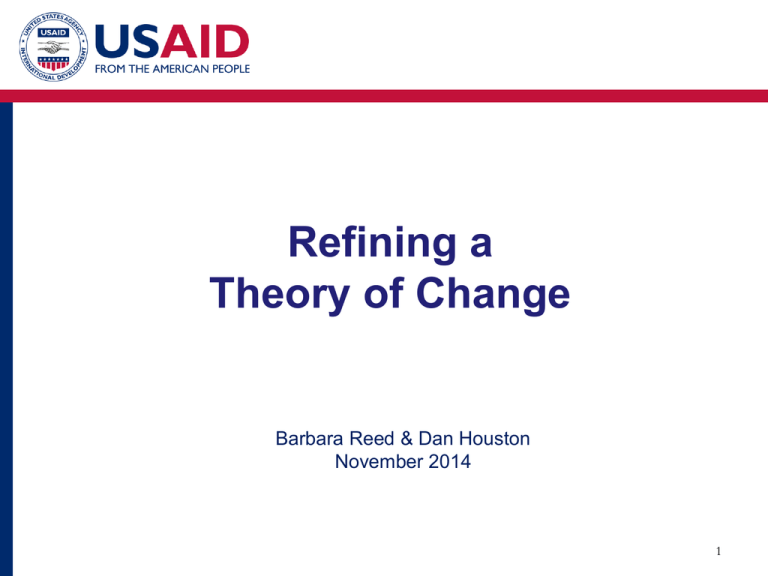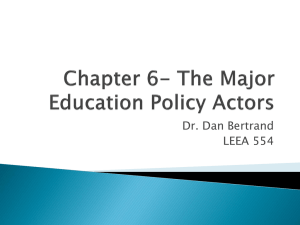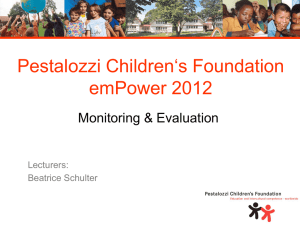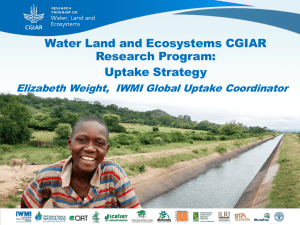Refining a Theory of Change - Food and Nutrition Technical
advertisement

Refining a Theory of Change Barbara Reed & Dan Houston November 2014 1 Session Objectives: By the end of the sessions, participants will have validated and refined the project’s Theory of Change (ToC)’s Purpose Level diagrams. 2 Elements of a ToC: Diagrams Project Level Goal Diagram • • • Project Level Goal Pathways of change that include all outcomes down to the immediate outcome level Outcomes that are critical to achieve the goal but will be produced by other actors Purpose Level Outcome Diagrams • • • • Purpose Level Outcome Pathways of change that include all outcomes and outputs Outcomes that are critical to achieve the goal but will be produced by other actors Assumptions 3 Part 1: Validating and Refining the Goal Program Goal: To reduce chronic malnutrition and food insecurity and build resilience among vulnerable populations in the districts of …... What is the evidence supports the need for the goal? Does the goal have any of the following logic pitfalls? Unclear wording Causality vs. Definition Two levels in one outcome How will the goal be measured? 4 Part 2: Validating and Refining the Outcomes Step 1: Based on evidence and your problem analysis; validate, refine and identify the outcomes that are necessary for the higher level outcome to be achieved Review the higher level outcome and ask “how” the higher result will be achieved. Keep going until all of the outcomes that are necessary and sufficient to achieve the higher level outcome have been identified. 5 Part 2: Validating and Refining the Outcomes Step 2: Confirm and refine how the project outcomes contribute to the higher level outcome Is the achievement of the project’s outcomes alone sufficient to achieve the higher level outcome? How will other actors contribute to these outcomes? If gaps remain, how will the necessary outcomes be achieved? Do you have the necessary and sufficient resources in order to achieve the outcome? 6 Part 2: Validating and Refining the Outcomes Step 3: Ensure that there are the no logic pitfalls: Unclear wording Not using “if…then” logic (asking “how” going down and why going up the pathways) Causality vs. Definition Duplication of outcomes at different levels Two levels in one outcome Using “capacity building” in result Not integrating gender and environment into logic 7 Part 2: Validating and Refining the Outcomes Step 4: Validate, refine and measure the assumptions: Rationales: Description of why the outcome is necessary for the achievement of the higher level outcome. What is the evidence that supports the validity of the assumption? What will happen if the assumptions fail? How can the project measure the assumptions? Global assumptions: The contextual or environmental conditions that are out of the control of the project but which must exist for the outcome to produce the link to the higher level outcome. What is the evidence that supports the validity of the assumption? What will happen if the assumptions fail? How can the project measure the assumptions? 8 Part 2: Validating and Refining the Outcomes Step 5: Identify how the project will measure the outcome (indicators): Are there FFP or other standard indicators that would apply? Is/Are the indicator(s) SMART? Specific Measurable Achievable Relevant Timely 9 Sample Process Tracking Form Outcome / Output Rationale (why needed to reach higher outcome) w/ evidence Assumption Indicators (Contextual or Environment Preconditions) w/ evidence Increased Access to Irrigation Irrigation facilitated multiple cropping seasons Final Evaluation Cyclones will not damage the irrigation schemes more than once during the course of the project – NOAA Notes/Follow -up Number of hectares under improved technologies or management practices as a result of USG (FFP) assistance 10 Part 3: Organize and Develop the Purpose Level Diagram Identify outcomes or outputs that lead to multiple outcomes and organize accordingly Use color, shapes, fonts to clearly distinguish: Purposes Outcomes and pathways (arrows) addressed by the project Outcomes and pathways addressed only by other actors Project outputs Other actors’ outputs Assumptions or associated references* 11 Part 4: Organize and Develop the Project Level Diagram Identify outcomes that lead to multiple outcomes and organize accordingly Use color, shapes, fonts to clearly distinguish: Goal Purposes Outcomes and pathways (arrows) addressed by the project Outcomes and pathways addressed only by other actors Project outputs Other actors’ outputs Assumptions or associated references* 12 Part 5: Organize and Develop the Project Level Diagram Identify outcomes that lead to multiple outcomes across different purposes & organize accordingly Use color, shapes, fonts to clearly distinguish: Goal Purposes Outcomes and pathways (arrows) addressed by the project Outcomes and pathways addressed only by other actors Project outputs Other actors’ outputs Assumptions or associated references* 13 Part 6: Write the narrative Summarize the major elements of the ToC Describe and provide evidence on how the problem analysis, assumptions, rationales relate to the long-term goal, outcomes (especially for non-project implementers), pathways and interventions, on what is not readily absorbed from the diagram Describe collaboration with other actors, including how their necessary outputs will be monitored Assess the risks that assumptions may fail 14






